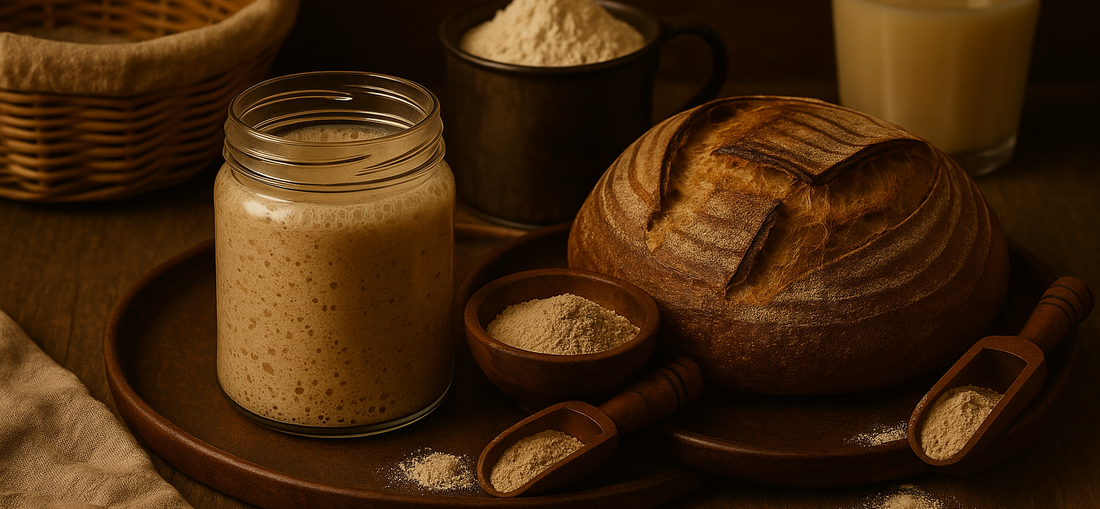
1800’s Sourdough Starter: A Living Legacy in a Jar
Share
1800’s Sourdough Starter: A Living Legacy in a Jar
Some things you don’t buy — you inherit.
Our 1800’s Sourdough Starter was passed down through generations of one family, and then gifted to me by my dear friend Kendal Mason during my nesting party for my fourth son. From the moment I opened that jar, I knew it was something special. Tangy, resilient, and beautifully active — it’s outperformed every other starter I’ve ever worked with.
It’s not just a starter. It’s a story.
And now, I’m honored to pass it on to your kitchen.
🌾 Why This Starter is Different
This isn’t a powdered packet from the store or a freeze-dried "just add water" shortcut. This is a living culture that’s been lovingly fed and kept alive for over a century. It's been nurtured with care, carried through generations, and made with:
-
Organic King Arthur All-Purpose Flour — trusted, clean, consistent
-
Filtered water from my Kangen machine — mineral-rich and chlorine-free
-
Stored in glass mason jars — no plastic, no metals, no weird residues
This starter is active, vibrant, and ready to bring your bread to life — with the depth, flavor, and rise that only time can create.
🛠 Before You Order: What You’ll Need
To care for this living culture and bake with it, you’ll need a few basics:
Essential Supplies:
-
1 or 2 quart-size glass jars (for storing and feeding)
-
A digital kitchen scale (feeding by weight is more accurate)
-
Organic all-purpose flour (King Arthur or similar)
-
Filtered water (chlorine-free is key for happy bacteria)
-
A clean towel and rubber band (to cover your jar loosely)
-
Optional: a dough scraper, banneton basket, and Dutch oven for baking
🌱 How to Keep It Alive in Your Fridge
Once your starter arrives:
-
Let it rest on the counter for a few hours after shipping.
-
Feed it with equal parts flour and filtered water by weight.
-
Example: 50g starter + 50g flour + 50g water
-
-
Stir, cover loosely, and let it sit at room temp for 4–8 hours until bubbly.
-
Once active, store it in the fridge and feed it once a week (or every 3–4 days if you bake often).
-
Always leave at least 1 tablespoon in the jar before feeding again — never wash it out unless something's truly gone wrong.
Want to bake? Pull it out, feed it, and let it get active at room temp before using.
🍞 Why Sourdough (and Not Store-Bought Bread)
Sourdough isn’t just trendy — it’s tried and true. Before commercial yeast existed, this was how bread was made. And it turns out, it’s better for us.
Benefits of sourdough:
-
Easier to digest thanks to natural fermentation
-
Lower in gluten and higher in nutrients
-
Supports gut health and reduces blood sugar spikes
-
Has a deeper, tangier flavor with real character
-
Stays fresh longer without preservatives
Store-bought bread is often full of sugar, additives, and quick-rise yeast that lacks depth. Sourdough takes time, but it gives so much more in return.
👩🍳 How to Make Sourdough Bread
There are hundreds of variations, but here’s a beginner-friendly outline using your new starter:
Simple Artisan Sourdough Loaf
-
Feed your starter and let it double in size (active and bubbly).
-
Mix:
-
100g active starter
-
375g warm filtered water
-
500g organic flour (all-purpose or bread flour)
-
10g sea salt
-
-
Mix, cover, and let rest 30 minutes. Then stretch and fold 4–6 times every 30 minutes.
-
Bulk ferment for 4–6 hours (or overnight in the fridge).
-
Shape into a round and place in a floured bowl or banneton.
-
Let rise 1–2 more hours, or refrigerate overnight.
-
Bake in a preheated Dutch oven at 475°F for 20 minutes covered, 20 minutes uncovered.
Result: crusty, chewy, golden sourdough made by your hands and a legacy culture.
🏡 From My Kitchen to Yours
This starter carries a piece of history — a mother culture that’s fed generations of families with love and intention. Every jar you buy is an invitation to slow down, get your hands in flour, and bake something real.
It’s not just about bread. It’s about belonging.
To the land. To the rhythm. To the wild, wonderful way food was meant to be.
From our homestead to yours — welcome to the sourdough life.
